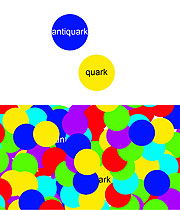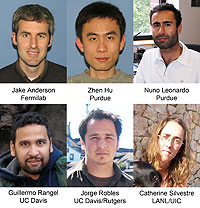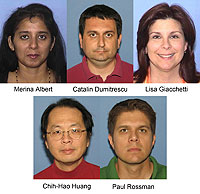|
Have a safe day!
Friday, March 2
2:00
Accelerator Controls Seminar - 1 West
Speaker: Andrey Petrov, Fermilab
Title: Synoptic; The Graphical Display Tool Available in the Fermilab Accelerator Control System
3:30 p.m.
DIRECTOR'S COFFEE BREAK - 2nd Flr X-Over
4 p.m.
Joint Experimental-Theoretical Physics Seminar - One West
Speaker: Matthew Jones, Purdue University
Title: Upsilon Polarization at CDF
Sunday, March 4
2:30 p.m.
Gallery Chamber Series - 2nd Flr X-Over
Performer: Arianna String Quartet
Tickets: $17
Monday, March 5
1 p.m.
Particle Astrophysics Seminar - One West
Speaker: Anders Pinzke, University of California, Santa Barbara
Title: Gamma-Ray Emission from Clusters of Galaxies –
A Competition Between Cosmic Rays and Dark Matter
3:30 p.m.
DIRECTOR'S COFFEE BREAK - 2nd Flr X-Over
4 p.m.
All Experimenters' Meeting - Curia II
Special Topic: Lifetime Studies of Cryogenic ICs for LAr TPC Readout
Click here for NALCAL,
a weekly calendar with links to additional information.
Upcoming conferences
|
|
Friday, March 2
- Breakfast: Chorizo burrito
- Smart cuisine: Chunky vegetable soup w/ orzo
- Buffalo chicken wings
- Cajun breaded catfish
- Smart cuisine: Teriyaki pork stir-fry
- Honey mustard ham & Swiss panini
- Assorted sliced pizza
- Carved turkey
Wilson Hall Cafe Menu
|
|
Friday, March 2
Dinner
Closed
Chez Leon Menu
Call x3524 to make your reservation. |
|
Tevatron experiments combine for new W boson mass measurement
Editor's note: The CDF measurement was reported in Fermilab Today on Thursday, Feb. 23. This press release announces the combined measurement from both CDF and DZero.
The world's most precise measurement of the mass of the W boson, one of nature's elementary particles, has been achieved by scientists from the CDF and DZero collaborations at the Department of Energy's Fermi National Accelerator Laboratory. The new measurement is an important, independent constraint of the mass of the theorized Higgs boson. It also provides a rigorous test of the Standard Model that serves as the blueprint for our world, detailing the properties of the building blocks of matter and how they interact.
The Higgs boson is the last undiscovered component of the Standard Model and theorized to give all other particles their masses. Scientists employ two techniques to find the hiding place of the Higgs particle: the direct production of Higgs particles and precision measurements of other particles and forces that could be influenced by the existence of Higgs particles. The new measurement of the W boson mass falls into the precision category.
The CDF collaboration measured the W boson mass to be 80387 +/- 19 MeV/c2. The DZero collaboration measured the particle's mass to be 80375 +-23 MeV/c2. The two new measurements, along with the addition of previous data from the earliest operation of the Tevatron, combine to produce a measurement of 80387 +- 17 MeV/c2, which has a precision of 0.02 percent.
These ultra-precise, rigorous measurements took up to five years for the collaborations to complete independently. The collaborations measured the particle's mass in six different ways, which all match and combine for a result that is twice as precise as the previous measurement.
Read the full press release here.
|
Fermilab roads re-opening
On Monday, March 5, the roads closed during the winter months will re-open. West Wilson, North Eola and Main Ring roads will all open with traffic resuming normally. In the event of late-season snow, the roads may temporarily close again. The green cones used to mark the snowplowing limits in Fermilab's parking lots may be removed by mid-March, after FESS looks at long-term weather forecasts. FESS will keep Fermilab employees, users and visitors as up-to-date as possible.
|
Not up to Standard
From The Economist, March 1, 2012
Why is the universe made of matter?
That the universe is made of matter is obvious enough. What bothers fundamental physicists, though, is why that is. The best current theory of particle physics, called the Standard Model, suggests that basically equal amounts of matter and antimatter should have been produced in the Big Bang. Famously, however, matter and antimatter annihilate on contact and disappear in a puff of pure energy, so a primordial equity between the two would have led to a lifeless, photon-filled universe. One possible reason for the apparent imbalance is a phenomenon called charge conjugation/parity violation (or CP violation for short).
If charge conjugation and parity were conserved, nature would treat particles and their antiversions, which carry the opposite electric charge and opposite value of a property called spin, alike. The Standard Model allows for a whiff of CP violation. But that is nowhere near enough of it to explain matter's cosmic dominance.
Last November an experiment called LHCb, which feeds off the world's biggest particle accelerator, the Large Hadron Collider (LHC) near Geneva, saw hints of excess CP violation beyond theorists' predictions. Now an experiment in America, known as CDF, has spotted something similar.
Read more
|
Daya Bay antineutrino detectors exceed performance goals
From PhysOrg.com, March 1, 2012
After just three months of operation, the Daya Bay Reactor Neutrino Experiment has far surpassed expectations, recording tens of thousands of particle interactions and paving the way to a better understanding of neutrinos and why the universe is built of matter rather than antimatter.
Antineutrino detectors designed and built by the Daya Bay collaboration with leadership from the UW-Madison are at the heart of the effort. Embedded under a mountain near the China Guangdong Nuclear Power Group power plant about 55 kilometers from Hong Kong, the 110-ton detectors record neutrinos emitted by the reactors to probe the properties of matter and antimatter.
"When we look at the universe today there is very little antimatter and we don't know where it all went," says UW-Madison physics professor Karsten Heeger, one of the leading scientists in the Daya Bay experiment.
Read more
|
|
Investigating exotic plasma
 |
Proton-proton collisions can result in a meson, while collisions involving lead nuclei can make it more difficult for the meson to form.
|
There are few places as complicated as the debris formed from a high-energy collision of two nuclei of atoms, and there is no facility that can muster as much energy as the LHC. For about a month each year, the LHC slams together two beams of nuclei from lead atoms. If the collision is head on, the 416 protons and neutrons involved in the collision melt, freeing the quarks and gluons. The resulting state of affairs is often called quark-gluon plasma (QGP). This mix hasn't been commonly seen in the universe since about a millionth of a second after the Big Bang.
In order to study the behavior of matter under these conditions, we turn to bottom and charm quarks. These particles decay into muons that do not experience the strong nuclear force, which lets them escape the plasma unscathed. By observing muons, we can understand the behavior of the parent quarks that are affected by the QGP.
In a collision, charm quarks can be produced in a meson called the J/ψ, (consisting of a charm quark and charm antimatter quark) while the bottom quarks can be produced in a meson called the γ, (which consists of a bottom quark/antiquark pair).
Read more
—Don Lincoln
 |
These analyzers contributed to this analysis.
|
 |
The CMS Data & Debugging Services Group at Fermilab is responsible for ensuring that the data continue to flow from CERN to Fermilab. They not only maintain our high-level storage services such as BlueArc, EOS, dCache and Lustre, but assist hundreds of LHC Physics Center users every year.
|
|
Geese police at Fermilab
The Geese Police and their dogs will be visiting the site every day for the next two months. They will concentrate their efforts in areas where aggressive geese have nested in the past. If you see or hear of aggressive geese, please notify FESS.
|
|